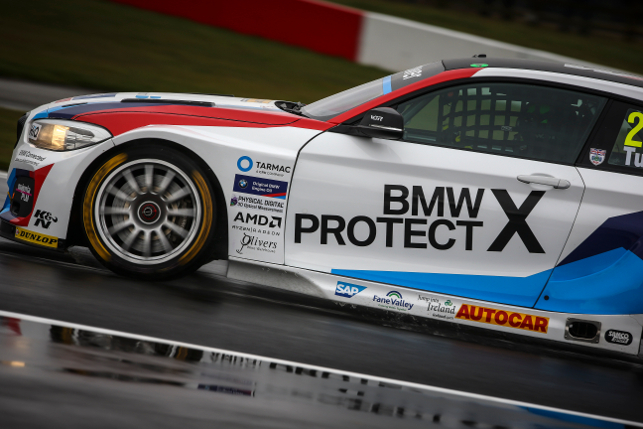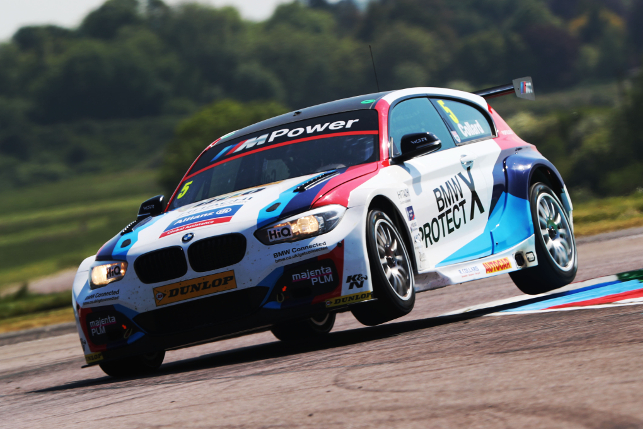SPONSORED CONTENT
In the competitive world of motorsport, a single second can mean the difference between first place and twenty-fifth. Which is why West Surrey Racing relies on HP and AMD.

The five times British Touring Car Championship-winning team uses a combination of HP’s professional workstations and AMD’s high-performance GPUs, both in its office and at the track, with Senior Engineer Drew MacDonald using an HP Z240 workstation equipped with AMD’s top-of-the-range Radeon Pro WX 9100 graphics card for design work, and an HP ZBook mobile workstation with AMD’s optimized graphics for rapid race-day data analysis.
Together, their power and reliability helps ensure that WSR completes the work within the narrow time frames permitted by the BTCC regulations – and that its cars stay at the front of the grid.
Four decades of success
On its foundation in 1981, West Surrey Racing quickly became one of Europe’s most successful racing teams, going on to work with many future Formula One and World Touring Car world champions. The list of names is an impressive hall of fame and an uptodate version can be found on the WSR website.
Having become the most successful team in the British Formula 3 Championship during the 1980s, WSR moved into the British Touring Car Championship, where it has continued its run of success, running race-winning factory BTCC programmes for Ford, Honda, MG, and most recently, BMW. In total, WSR has won more than 100 class and outright wins in the BTCC, including five outright championship titles and nine independents’ crowns.
But while its winning record might suggest a large team, WSR has just one race engineer and one data engineer for each of the three BTCC cars it currently operates. “We all wear multiple hats,” says Senior Engineer Drew MacDonald. “I’m a race engineer as well as a designer, and I help with production too.”
From road car to race winner
The process of converting a road car into a race vehicle begins by taking a bare-body shell from the production line, which WSR fits out with a mixture of custom parts and those specified by the BTCC’s technical regulations.
“There are a lot of championship controlled parts, like the front and rear suspension,” explains MacDonald. “They’re mounted on sub-frames – big tubular structures – which have to fit into the car and pick up on the roll cage. The regulations on the design of the roll cage are very strict, but the wheel base of the car determines how you fit it between the two sub-frames.”
Other key engineering challenges include the design of the engine. “The engine is probably the most freely modifiable part of the car,” says MacDonald. “You have to run the standard crank, but you can do your own pistons, your own camshafts. The intercooler core is mandated, but you can do what you want with the end tanks. We also design our own exhaust, radiator system and engine mounts.”
WSR is even responsible for designing the bodywork: something that plays a critical role in the car’s aerodynamics. “We go to a wind tunnel to play with it,” says MacDonald. “Ultimately, the more down force you create, the better, but it’s a question of how you balance it from front to rear.”

Pushing the GPU to the limit
Although WSR runs BMW’s official team in the British Touring Car Championships, the CAD files for its road cars remain a closely guarded commercial secret. Instead, WSR’s design process begins with intricate 3D scans of their body shells and engines, captured by specialist firm Physical Digital.
“The scan data files are massive,” says MacDonald. “Physical Digital usually thin them down to two million points for us, but it depends on the part.”
Such dense scan data pushes the display capabilities of MacDonald’s workstation to the limit – as does the complexity of the models generated from it: the master file for WSR’s current race car, created in Siemens NX™, references over 8,000 individual CAD components.
To compound the problem, MacDonald prefers to work with all the parts of the model displayed, but set to transparent. “Transparency is a killer for your graphics card,” he points out. “Siemens NX warns you when you set transparency on a part that you might not have enough memory – and I can be trying to look at up to 10GB of data on screen at a time.”
Seamless interactivity and fast analysis
Enter HP’s specialist Z240 workstation and AMD’s top-of-the-range Radeon Pro WX 9100 graphics card. With its 32GB of RAM and 4GHz CPU, the Z240 powers through general processing tasks, while the Radeon Pro WX 9100 GPU’s 16GB of blazing fast HBM2 memory ensures that even the largest CAD file remains seamlessly interactive.
“I noticed a difference immediately,” says MacDonald. “Parts are quicker to load and display, and a lot more fluid to manipulate on screen. On a slower card, if you accidentally hover over a part on the way to the one next to it, you get stuck on the facet body for ages before you can move the cursor again. You get frustrated by silly things like that.”
Once the CAD model of a car is complete, MacDonald uses NX as an analysis tool to calculate the optimum positions for the suspension geometry within the limits permitted by the BTCC rules. Thanks to Siemen NX’s ability to make use of the GPU for processing, the Radeon Pro WX 9100 GPU’s 12.29 TFLOPS of peak single-precision compute performance makes short work of such tasks.
And on touring cars, fast turnaround is essential. “It isn’t like working on a road car, where you have a full crew in the office, and can spend a year designing next year’s model,” points out MacDonald. “You don’t really have time to do multiple iterations: you have to get it right first time.

Power on the move
As well as using HP and AMD’s hardware in the office, WSR takes it to the track. To analyze the engine and suspension data collected by his car’s on-board logger boxes during practice sessions, MacDonald uses an HP ZBook mobile workstation with 32GB RAM, a 2.6GHz processor, and an AMD GPU.
“You have a workbook within the analysis tool [Cosworth’s Pi Toolbox], so it’s a bit like using the tabs within a spreadsheet,” he says. “In each tab, you can display as many windows as you like: scatter plots, frequency plots, tables. If you’re looking at three drivers over 10 laps, the data can take several seconds to load.”
But during qualifying days, even seconds count. “You do the first practice session at 9.30 in the morning, then you have a maximum of two hours in which to analyze all your data, make any changes necessary, and leave the mechanics enough time to make those changes before the next session,” says MacDonald. “Realistically, you might only have 45 minutes to check everything – and the effect can be massive. If you get it wrong, you can put your car at the back of the grid.
”In such stressful situations, MacDonald has learned to rely on his hardware. “I got the ZBook before I got my HP desktop machine, and I noticed the difference straight away,” he says. “My previous laptop used another make of GPU, and I definitely noticed the difference with the graphics card.”
HP, AMD and WSR: a winning team
Thanks to HP’s powerful specialist workstations, coupled with AMD’s high-performance professional graphics cards, West Surrey Racing is able to complete complex technical analyses within the tight time frames necessary to sustain its winning record in the British Touring Car Championship.
Having tested his current set-up to the limits, MacDonald says that he plans to stick with both manufacturers’ hardware, describing the decision as a “no-brainer”
“As an engineer in motorsport, you’re always looking for performance,” he points out. “Now that I’ve experienced the speed of AMD’s Radeon Pro WX 9100, I want another one. I’ve tried other [makes of graphics card]. They don’t come close.”

With the AMD Radeon Pro WX9100 GPU parts were quicker to load and display, and the complex car models a lot more fluid to manipulate on screen
Click here to learn more about AMD RADEON PRO GPUs
About West Surrey Racing
Founded by Dick Bennetts in 1981, West Surrey Racing is one of Europe’s most successful racing teams, having tasted success with World Champion drivers such as Ayrton Senna, Mika Häkkinen, Nigel Mansell, and Andy Priaulx. After becoming the most successful team in the British Formula 3 Championship during the 1980s, WSR moved into the British Touring Car Championship, running race-winning factory BTCC programmes for Ford, Honda, MG, and BMW, and taking five outright championship titles and nine independents’ crowns. It is also a race winner in the FIA World Touring Car Championship. For more information,
About AMD
For more than 45 years AMD has driven innovation in high performance computing, graphics, and visualization technologies— the building blocks for gaming, immersive platforms, and the datacenter. Hundreds of millions of consumers, leading Fortune 500 businesses, and cutting-edge scientific research facilities around the world rely on AMD technology daily to improve how they live, work, and play. AMD employees around the world are focused on building great products that push the boundaries of what is possible. For more information about how AMD is enabling today and inspiring tomorrow,
pro.radeon.com

West Surrey Racing, HP and AMD – a winning team
[sponsored content]
10






